Corrosion engineering
Corrosion engineering is an engineering specialty that applies scientific, technical, engineering skills, and knowledge of natural laws and physical resources to design and implement materials, structures, devices, systems, and procedures to manage corrosion.[1]
General background
From a holistic perspective, corrosion is the phenomenon of metals returning to the state they are found in nature. The driving force that causes metals to corrode is a consequence of their temporary existence in metallic form. To produce metals starting from naturally occurring minerals and ores, it is necessary to provide a certain amount of energy, e.g. iron ore in a blast furnace. It is therefore thermodynamically inevitable that these metals when exposed to various environments would revert to their state found in nature. Corrosion and corrosion engineering thus involves a study of chemical kinetics, thermodynamics and electrochemistry.
Generally related to Metallurgy or Materials Science, corrosion engineering also relates to non-metallics including ceramics, cement, Composite material and conductive materials such as carbon / graphite. Corrosion Engineers often manage other not-strictly-corrosion processes including (but not restricted to) cracking, brittle fracture, crazing, fretting, erosion, and more typically categorized as Infrastructure asset management. In the 1990s, Imperial College London even offered a Master of Science degree entitled "The Corrosion of Engineering Materials".[2] UMIST - University of Manchester Institute of Science and Technology and now part of the University of Manchester also offered a similar course. Corrosion Engineering master's degree courses are available worldwide and the curricula contains study material about the control and understanding of corrosion.
In the year 1995, it was reported that the costs of corrosion nationwide in the USA were nearly $300 billion per year.[3] This confirmed earlier reports of damage to the world economy caused by corrosion.[4]
Corrosion engineering groups have formed around the world to educate, prevent, slow, and manage corrosion. These include the National Association of Corrosion Engineers (NACE), the European Federation of Corrosion (EFC), and The Institute of Corrosion in the UK. The corrosion engineer's main task is to economically and safely manage the effects of corrosion on materials.
Zaki Ahmad in his book "Principles of corrosion engineering and corrosion control" states that "Corrosion engineering is the application of the principles evolved from corrosion science to minimize or prevent corrosion".[5] Shreir et al. suggest likewise in their large 2 volume work titled Corrosion.[6] Corrosion engineering involves designing of corrosion prevention schemes and implementation of specific codes and practices. Corrosion prevention measures, including Cathodic protection, designing to prevent corrosion and coating of structures fall within the regime of corrosion engineering. However, corrosion science and engineering go hand-in-hand and they cannot be separated: it is a permanent marriage to produce new and better methods of protection from time to time. This may include the use of Corrosion inhibitors. In the "Handbook of corrosion engineering", the author Pierre R. Roberge states "Corrosion is the destructive attack of a material by reaction with its environment. The serious consequences of the corrosion process have become a problem of worldwide significance".[7]
Some of the most notable contributors to the Corrosion Engineering discipline include among others:
•Michael Faraday (1791–1867) •Marcel Pourbaix (1904–1998) •Dr. Herbert H. Uhlig (1907–1993) •Ulick Richardson Evans (1889–1980) •Mars G. Fontana (1910–1988) •Melvin Romanoff •Pierre R. Roberge
Types of corrosion situations
Corrosion engineers and consultants tend to specialize in Internal or External corrosion scenarios. In both, they may provide corrosion control recommendations, failure analysis investigations, sell corrosion control products, or provide installation or design of corrosion control and monitoring systems.[8][9][10][11][12] Every material has its weakness. Aluminum, galvanized/zinc coatings, brass, and copper do not survive well in very alkaline or very acidic pH environments. Copper and brasses do not survive well in high nitrate or ammonia environments. Carbon steels and iron do not survive well in low soil resistivity and high chloride environments. High chloride environments can even overcome and attack steel encased in normally protective concrete. Concrete does not survive well in high sulfate and acidic environments. And nothing survives well in high sulfide and low redox potential environments with corrosive bacteria.
External corrosion
Underground soil side corrosion
Underground corrosion control engineers collect soil samples to test soil chemistry for corrosive factors such as pH, minimum soil resistivity, chlorides, sulfates, ammonia, nitrates, sulfide, and redox potential. They collect samples from the depth that infrastructure will occupy, because soil properties may change from strata to strata. The minimum test of in-situ soil resistivity is measured using the Wenner four pin method if often performed to judge a site's corrosivity. However, during a dry period, the test may not show actual corrosivity, since underground condensation can leave soil in contact with buried metal surfaces more moist. This is why measuring a soil's minimum or saturated resistivity is important. Soil resistivity testing alone does not identify corrosive elements.[13] Corrosion engineers can investigate locations experiencing active corrosion using above ground survey methods and design corrosion control systems such as cathodic protection to stop or reduce the rate of corrosion.
Geotechnical engineers typically do not practice corrosion engineering, and refer clients to a corrosion engineer if soil resistivity is below 3,000 ohm-cm or less, depending the soil corrosivity categorization table they read. Unfortunately, an old dairy farm can have soil resistivities above 3,000 ohm-cm and still contain corrosive ammonia and nitrate levels that corrode copper piping or grounding rods. A general saying about corrosion is, "If the soil is great for farming, it is great for corrosion."
Underwater external corrosion
Underwater corrosion engineers apply the same principals used in underground corrosion control but use specially trained and certified scuba divers for condition assessment, and corrosion control system installation and commissioning. The main difference being in the type of reference cells used to collect voltage readings.
Atmospheric corrosion
Prevention of atmospheric corrosion is typically handled by use of materials selection and coatings specifications. The use of zinc coatings also known as galvanization on steel structures is a form of cathodic protection and also a form of coating. Small scratches are expected to occur in the galvanized coating over time. The zinc being more active in the galvanic series corrodes in preference to the underlying steel and the corrosion products fil the scratch preventing further corrosion. As long as the scratches are fine, condensation moisture should not corrode the underlying steel as long as both the zinc and steel are in contact. As long as there is moisture, the zinc corrodes and eventually disappears.
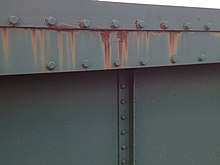

Humid and splash zone corrosion
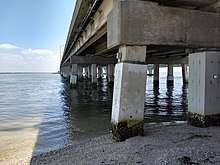
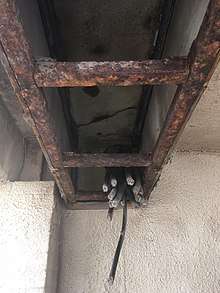
A significant amount of corrosion of fences is due to landscaper tools scratching fence coatings and irrigation sprinklers spraying these damaged fences. Recycled water typically has a higher salt content than potable drinking water, meaning that it is more corrosive than regular tap water. The same risk from damage and water spray exists for above ground piping and backflow preventers. Fiberglass covers, cages, and concrete footings have worked well to keep tools at an arm's length. Even the location where your roof drain splashes down can matter. Drainage from a home's roof valley can fall directly down onto a gas meter causing its piping to corrode at an accelerated rate reaching 50% wall thickness within 4 years. It is the same effect as a splash zone in the ocean, or in a pool with lot of oxygen and agitation that removes material as it corrodes.
Tanks or structural tubing such as bench seat supports or amusement park rides can accumulate water and moisture if the structure does not allow for drainage. This humid environment can then lead to internal corrosion of the structure affecting the structural integrity. The same can happen in tropical environments leading to external corrosion.
Galvanic corrosion
See main article Galvanic corrosion
Galvanic corrosion (also called bimetallic corrosion) is an electrochemical process in which one metal (more active one) corrodes preferentially when it is in electrical contact with another dissimilar metal, in the presence of an electrolyte.[14] A similar galvanic reaction is exploited in primary cells to generate a useful electrical voltage to power portable devices - a classic example being a cell with zinc and copper electrodes. Galvanic corrosion happens when there are an active metal and a more noble metal in contact in the presence of electrolyte.
Pitting corrosion
See main article Pitting corrosion and Pitting resistance equivalent number
Pitting corrosion, or pitting, is extremely localized corrosion that leads to the creation of small holes in the material - nearly always a metal. The failures resulting from this form of corrosion can be catastrophic. With general corrosion it is easier to predict the amount of material that will be lost over time and this can be designed into the engineered structure. Pitting, like crevice corrosion can cause a catastrophic failure with very little loss of material. Pitting corrosion happens for passive materials.
Crevice corrosion
See main article Crevice corrosion
Crevice corrosion is a type of localized corrosion with a very similar mechanism to pitting corrosion.
Stress corrosion cracking
See main article Stress corrosion cracking
Stress corrosion cracking (SCC) is the growth of a crack in a Corrosion|corrosive environment. It requires three conditions to take place: 1)corrosive environment 2)stress 3)susceptible material. SCC can lead to unexpected sudden and hence catastrophic failure of normally ductile metals under tensile stress. This is usually exacerbated at elevated temperature. SCC is highly chemically specific in that certain alloys are likely to undergo SCC only when exposed to a small number of chemical environments. It is common for SCC to go undetected prior to failure. SCC usually quite progresses rapidly after initial crack initiation, and is seen more often in alloys as opposed to pure metals. The corrosion engineer thus must be aware of this phenomenon.[15]
Filiform Corrosion
Filiform corrosion may be considered as a type of crevice corrosion and is sometimes seen on metals coated with an organic coating (paint).
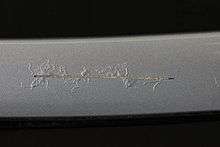
Corrosion fatigue
See main article Corrosion fatigue
Microbial corrosion
See main article Microbial corrosion
High Temperature corrosion
See main article High-temperature corrosion
Internal corrosion
The same principals of external corrosion control can be applied to internal corrosion but due to accessibility, the approaches can be different. Thus special instruments for internal corrosion control and inspection are used that are not used in external corrosion control. Video scoping of pipes and high tech smart pigs are used for internal inspections. The smart pigs can be inserted into a pipe system at one point and "caught" far down the line. The use of corrosion inhibitors, material selection, and internal coatings are mainly used to control corrosion in piping while anodes along with coatings are used to control corrosion in tanks.
Internal corrosion challenges apply to the following:
- Water pipe corrosion - Gas pipe corrosion - Oil pipe corrosion - Water tank reservoir corrosion
Good design to prevent corrosion situations
Corrosion engineering involves good design. Using a rounded edge rather than an acute edge reduces corrosion, as does not coupling by welding or other joining method, two dissimilar metals to avoid galvanic corrosion. Avoiding having a small anode (or anodic material) next to a large cathode (or cathodic material) is good practice. As an example, weld material should always be more noble than the surrounding material. Stainless steel should not be used to handle deoxygenated solutions as the stainless steel relies on oxygen to maintain passivation.
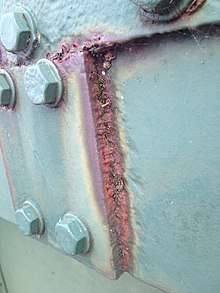
See also
- Corrosion societies
- Corrosion inhibitor
- Stress corrosion cracking
- Environmental stress cracking
- Structural failure
- Fracture Mechanics
- Electrochemistry
- Anodic protection
- Coating
References
- 1950-, Trethewey, Kenneth R. (Kenneth Richard) (1988). Corrosion for students of science and engineering. Chamberlain, John, 1934-. Harlow, Essex, England: Longman Scientific & Technical. ISBN 0582450896. OCLC 15083645.CS1 maint: numeric names: authors list (link)
- Sidky and Hocking (May 1994). "MSc Corrosion of Engineering Materials". Imperial College Lecture Notes.
- Fontana, Mars G (2005). Corrosion engineering (3rd ed.). New Delhi: Tata McGraw-Hill. ISBN 0070607443. OCLC 225414435.
- Trethewey, Kenneth R.; Chamberlain, John (1988). Corrosion for students of science and engineering. Harlow, Essex, England: Longman Scientific & Technical. ISBN 0582450896. OCLC 15083645.
- Zaki., Ahmad (2006). Principles of corrosion engineering and corrosion control. Institution of Chemical Engineers (Great Britain) (1st ed.). Boston, MA: Elsevier/BH. ISBN 9780080480336. OCLC 147962712.
- Shreir, L. L.; Burstein, G. T.; Jarman, R. A. (1994). Corrosion (3rd ed.). Oxford: Butterworth-Heinemann. ISBN 159124501X. OCLC 53032654.
- Roberge, Pierre R. (2012). Handbook of corrosion engineering (2nd ed.). New York: McGraw-Hill. ISBN 9780071750370. OCLC 801050825.
- R., Roberge, Pierre (2008). Corrosion engineering : principles and practice. New York: McGraw-Hill. ISBN 9780071640879. OCLC 228826475.
- Uhlig's corrosion handbook. Revie, R. Winston (Robert Winston), 1944-, Uhlig, Herbert Henry, 1907- (Third ed.). Hoboken, New Jersey. March 2011. ISBN 9780470872857. OCLC 729724608.CS1 maint: others (link)
- 1944-, Revie, R. Winston (Robert Winston) (2008-05-16). Corrosion and corrosion control : an introduction to corrosion science and engineering. Uhlig, Herbert Henry, 1907- (Fourth ed.). Hoboken, New Jersey. ISBN 9780470277256. OCLC 228416767.CS1 maint: numeric names: authors list (link)
- Zaki., Ahmad (2006). Principles of corrosion engineering and corrosion control. Institution of Chemical Engineers (Great Britain) (1st ed.). Boston, MA: Elsevier/BH. ISBN 9780080480336. OCLC 147962712.
- Volkan, Cicek. Corrosion engineering. Salem, Massachusetts. ISBN 9781118720752. OCLC 878554832.
- "Archived copy". Archived from the original on 2018-08-23. Retrieved 2017-08-11.CS1 maint: archived copy as title (link)
- "Galvanic Corrosion". www.nace.org. Archived from the original on 2018-12-22. Retrieved 2018-12-21.
- "Stress Corrosion Cracking (SCC)". www.nace.org. Archived from the original on 2018-12-22. Retrieved 2018-12-21.
External links
| Wikimedia Commons has media related to Corrosion. |
- NACE (formerly known as the National Association of Corrosion Engineers) NACE International
- European Federation of Corrosion http://www.efcweb.org/
- The Institute of Corrosion UK